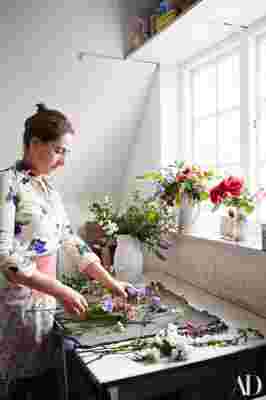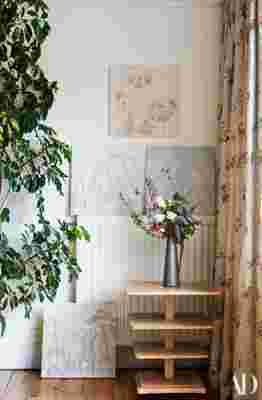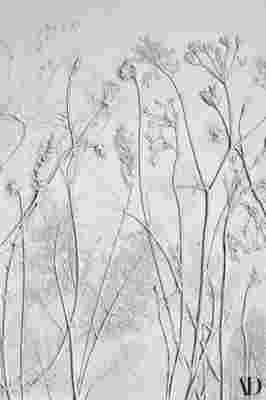Rachel Dein:

Dein arranging wildflowers.
It’s a cold day in March, and Rachel Dein has spring fever. “I hope it speeds up,” says the London-based artist, understandably impatient. Once the seasons change, she’ll have a brief window to forage for her favorite material—wildflowers. “I don’t take too many,” she says. “Just a few weeds and daisies, bluebells, or yarrows.” Dein then acts fast, gently pressing the fresh blooms into clay, removing them to create an impression, and pouring plaster into the mold to make panels that seem to freeze the plants in time. Of course, she’s found ways to keep herself busy all year, like casting a 30-foot-long branch in concrete. Other recent commissions include small panels for the shop at London’s Chelsea Physic Garden that were made using medicinal herbs grown there. Says Dein, “They represent a time and a place.” —Hannah Martin

Finished works line her London studio.

A plaster panel.
Fresh blooms pressed into clay.
Stuart Thornton:
Thornton gathering leaves at the Agnelli Estate in Villar Persoa, Italy.
Stuart Thornton must destroy nature to perfect it. “If you just press a plant, all you get is a lot of dead leaves—nothing pretty about it,” the dashing Brit explains. Instead Thornton, who shuttles between Italy and England, takes a deconstructivist approach to his art. After gathering specimens—often from the gardens of friends and clients like style queen Marella Agnelli, for whom he works as majordomo—he separates stems from leaves, petals from flowers, dries them, and then selectively recombines the components into idealized, enrapturing botanicals that can reach six feet or more in height. “The form is what’s important,” Thornton says, adding with a chuckle, “It’s still a dead plant but one that looks good.” —Mitchell Owens
Gunnera leaves above Villa Necchi Campiglio's pool in Milan.
Framed Thorntons at Marella Agnelli's home in Corsica.
Clare Potter:
Potter at her Manhattan workshop.
Hair and Makeup by Mary Guthrie using Lancöme for artists by Timothy Priano
“Flowers might seem twee, but they are an endless challenge,” says acclaimed ceramist Clare Potter . “I always want to make them looser or taller, but there are limits to what clay allows you to do.” That being said, the Manhattan talent has cultivated a garden of delights, one luscious ceramic bloom at a time: bruise- color hellebores, confetti-like sweet peas, striped tulips, and more, gently washed with layers of color and free from shiny glazes “so they look softer, the feeling of life.” Fruit and vegetables are part of Potter’s oeuvre too, wonders that recall long-ago works by Chelsea and Meissen. As she modestly says, “I’m just one in a long line of people who have done this for centuries.” —Mitchell Owens
A ceramic bouquet of peonies.
An arrangement of tulips, fritillaries, and hydrangeas.
For the full story, subscribe now and get the digital edition immediately.

Leave a Reply